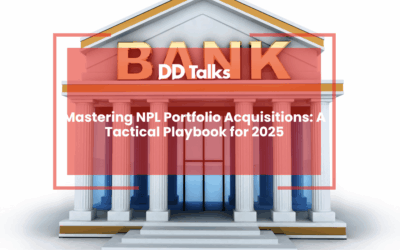Essential Insights for Re-Performing Loan Investors
- Re-performing loans (RPLs) represent a growing asset class in Europe, with approximately 15% CAGR since 2015, offering value recovery opportunities for banks and attractive yields for investors.
- Unlike NPLs, re-performing loans have resumed payments after modification, demonstrating improving credit characteristics while maintaining higher risk profiles than traditional performing loans.
- RPL securitization has evolved significantly, with transaction volumes increasing by over 200% between 2016-2021, creating structured investment opportunities across the risk spectrum.
- Successful RPL investing requires managing specific risk factors, including 20-30% re-default rates within two years, unpredictable prepayment behavior, and servicing quality variations.
- The regulatory landscape combines EBA guidelines, capital requirements, consumer protection measures, and data privacy regulations, favoring institutional investors with sophisticated compliance capabilities.
- Effective investment strategies include buy-and-hold approaches, active management through specialized servicing, securitization structures, and geographic specialization to leverage local market expertise.
Table of Contents
- Understanding Re-Performing Loans in Today’s Financial Landscape
- How Do Re-Performing Loans Differ from Non-Performing Loans?
- The Evolution of the RPL Market: Growth Trends and Forecasts
- RPL Securitization: Creating Investment Opportunities
- Non-QM Loans and Their Relationship to Re-Performing Debt
- Key Risk Factors in Distressed Mortgage Investing
- Regulatory Framework Governing the Re-Performing Loan Market
- Strategic Approaches to Investing in Re-Performing Loans
Understanding Re-Performing Loans in Today’s Financial Landscape
Re-performing loans (RPLs) represent a significant yet often overlooked segment of the European banking sector. These are loans that were previously delinquent—typically for 90 days or more—but have since resumed payments according to modified or original terms. The resurgence of RPLs has been particularly notable in the aftermath of the 2008 financial crisis and more recently following the economic disruptions caused by the COVID-19 pandemic.
In today’s financial landscape, RPLs have emerged as valuable assets for banks and investors alike. Financial institutions across Europe have increasingly recognised the potential to recover value from previously written-down assets through loan modification and debt restructuring strategies. These modifications might include extending the loan term, reducing interest rates, or adjusting payment schedules to accommodate borrowers’ financial circumstances.
The RPL market has evolved significantly, with specialised servicers developing sophisticated approaches to managing these assets. Through careful loan portfolio management and targeted intervention strategies, servicers can transform non-performing exposures into cash-flowing assets. This transformation not only benefits financial institutions by improving their balance sheets but also provides borrowers with sustainable pathways to fulfil their financial obligations.
How Do Re-Performing Loans Differ from Non-Performing Loans?
The distinction between re-performing loans and non-performing loans (NPLs) is crucial for understanding the distressed debt landscape. Non-performing loans are credit facilities where borrowers have failed to make scheduled payments for an extended period, typically 90 days or more. These loans represent significant risk and require substantial provisioning on bank balance sheets, creating regulatory and financial pressure for lenders.
Re-performing loans, by contrast, have transitioned from non-performing status back to a state of regular payment, albeit often under modified terms. This transition typically occurs through loan modification processes that address the underlying causes of default. While NPLs represent ongoing financial distress, RPLs indicate a resolution pathway and potential value recovery.
The performance trajectory also differs significantly. NPLs continue to deteriorate in value without intervention, whereas RPLs demonstrate improving credit characteristics over time. Default rates for RPLs tend to decrease as the loan establishes a consistent payment history, though they generally remain higher than those for loans that never experienced delinquency.
From an accounting and regulatory perspective, the classification shift from NPL to RPL allows financial institutions to reduce loan loss provisions and improve capital ratios. This reclassification typically requires a demonstrated period of consistent payments, usually between 6-12 months, depending on the jurisdiction and specific regulatory framework. Understanding these distinctions is essential for investors navigating the secondary mortgage market.
The Evolution of the RPL Market: Growth Trends and Forecasts
The European re-performing loan market has undergone remarkable transformation over the past decade, evolving from a niche segment to a substantial component of the secondary mortgage market. Following the European debt crisis, countries like Italy, Spain, Greece, and Ireland experienced significant growth in their RPL markets as banks sought to address mounting non-performing exposures.
Recent data indicates that the RPL market in Europe has expanded at a compound annual growth rate of approximately 15% since 2015. This growth has been driven by several factors, including regulatory pressure on banks to reduce non-performing loan ratios, the development of specialised loan servicing capabilities, and increased investor appetite for yield in a low-interest-rate environment.
Market forecasts suggest continued expansion, with particular acceleration in Southern and Eastern European markets where NPL ratios remain elevated. The European Banking Authority’s focus on NPL reduction has created structural incentives for banks to actively manage distressed portfolios, further stimulating the RPL market. Additionally, the economic impact of the COVID-19 pandemic has generated a new wave of loan modifications that will likely transition into the RPL category as economies recover.
Institutional investors, including private equity firms, hedge funds, and specialised credit funds, have increasingly allocated capital to this asset class, recognising the potential for attractive risk-adjusted returns. This influx of investment has supported market liquidity and contributed to more sophisticated pricing models for RPL portfolios.
RPL Securitization: Creating Investment Opportunities
RPL securitization has emerged as a sophisticated mechanism for banks and investors to unlock value from previously distressed assets. This process involves pooling re-performing loans into structured securities that can be sold to investors with varying risk appetites. The European securitization market for RPLs has grown substantially, with transaction volumes increasing by over 200% between 2016 and 2021.
The structure of RPL securitizations typically involves multiple tranches with different risk-return profiles. Senior tranches offer lower yields but greater protection against default, while subordinated tranches provide higher potential returns with corresponding increased risk exposure. This stratification allows for broader market participation across the investor spectrum, from conservative pension funds to opportunistic hedge funds.
Mortgage-backed securities derived from RPLs differ from traditional MBS in several key aspects. The underlying loans have demonstrated resilience through previous financial distress, often benefiting from loan modifications that have made them more sustainable for borrowers. However, they also carry unique performance characteristics, including higher prepayment volatility and more complex default patterns that require specialised analysis.
Recent innovations in RPL securitization include the integration of digital platforms for loan performance monitoring, enhanced transparency measures, and the development of social impact metrics for portfolios that have successfully kept borrowers in their homes. These advancements have contributed to greater market acceptance and improved liquidity for RPL-backed securities, creating a more robust investment ecosystem.
Non-QM Loans and Their Relationship to Re-Performing Debt
Non-Qualified Mortgage (Non-QM) loans and re-performing loans represent distinct yet interconnected segments of the alternative lending landscape. Non-QM loans are credit facilities that fall outside the strict underwriting criteria established by regulatory frameworks such as the European Mortgage Credit Directive or similar national regulations. These loans cater to borrowers who may have irregular income patterns, self-employment status, or other characteristics that don’t align with traditional lending parameters.
The relationship between Non-QM loans and re-performing debt is multifaceted. Both categories exist outside conventional prime lending markets and require specialised servicing approaches. Additionally, Non-QM loans often experience higher delinquency rates than their qualified counterparts, creating a pipeline of potential future re-performing loans when effectively managed through modification programmes.
Investors active in both markets benefit from complementary expertise in alternative credit assessment and distressed asset management. The analytical frameworks used to evaluate Non-QM borrowers share similarities with those employed to assess the rehabilitation potential of delinquent loans. This overlap has led to the emergence of investment funds and servicing platforms that specialise in both asset classes.
From a regulatory perspective, both Non-QM and re-performing loans face enhanced scrutiny regarding consumer protection and risk management practices. Financial institutions active in these markets must navigate complex compliance requirements while developing sustainable lending and modification strategies that address borrower needs and investor expectations.
Key Risk Factors in Distressed Mortgage Investing
Investing in distressed mortgage assets, particularly re-performing loans, entails navigating a complex risk landscape that requires sophisticated analysis and management strategies. Credit risk remains the foremost concern, as RPLs have demonstrated previous payment difficulties and may exhibit higher re-default rates than loans without delinquency history. Historical data suggests that between 20-30% of modified loans experience subsequent delinquency within two years, though this varies significantly based on modification terms and economic conditions.
Prepayment risk presents another significant challenge for RPL investors. As borrowers’ financial situations improve or they refinance into more favourable conventional loans, early repayment can reduce expected returns, particularly for investments purchased at a discount to face value. This risk is compounded by the difficulty in modelling prepayment behaviour for previously distressed borrowers, whose actions may not align with traditional prepayment models.
Servicing quality represents a critical operational risk factor. The performance of RPL portfolios depends heavily on the effectiveness of loan servicers in maintaining borrower engagement, addressing emerging payment difficulties promptly, and implementing appropriate modification strategies when necessary. Variations in servicing approaches can significantly impact portfolio outcomes, creating both risks and opportunities for investors with servicing expertise.
Regulatory and legal risks also feature prominently in distressed mortgage investing. Changes in foreclosure laws, consumer protection regulations, or banking supervision frameworks can materially affect the value and management options for RPL portfolios. These risks are particularly pronounced in cross-border European investments, where regulatory approaches to distressed debt vary substantially between jurisdictions.
Regulatory Framework Governing the Re-Performing Loan Market
The regulatory landscape for re-performing loans in Europe is characterised by a multi-layered framework that combines EU-wide directives with national implementation variations. The European Banking Authority (EBA) has established guidelines on the management of non-performing and forborne exposures that directly impact how financial institutions classify, manage, and report re-performing loans. These guidelines require banks to implement comprehensive strategies for NPL reduction and establish clear criteria for when modified loans can be reclassified as performing.
Capital requirements represent a significant regulatory consideration for institutions holding RPLs. Under the Basel framework and its European implementation through the Capital Requirements Regulation (CRR), banks must allocate appropriate capital against these assets based on their risk characteristics. The introduction of calendar provisioning rules has created additional incentives for banks to actively manage distressed exposures, contributing to the growth of the RPL market.
Consumer protection regulations also substantially influence the RPL landscape. The European Mortgage Credit Directive establishes requirements for responsible lending and borrower treatment that extend to loan modification practices. These protections ensure that restructuring arrangements are sustainable and appropriate for borrowers’ circumstances, balancing creditor rights with consumer welfare considerations.
Data protection and privacy regulations, particularly the General Data Protection Regulation (GDPR), add another layer of complexity to RPL transactions. The transfer and management of loan portfolios involve significant personal data processing, requiring robust compliance frameworks and careful due diligence during portfolio acquisitions. These requirements have contributed to the professionalisation of the RPL market, favouring institutional investors with sophisticated compliance capabilities.
Strategic Approaches to Investing in Re-Performing Loans
Successful investment in the re-performing loan market requires tailored strategies that address the unique characteristics of these assets. Buy-and-hold approaches focus on capturing the yield premium offered by RPLs compared to performing loans with similar characteristics. This strategy benefits from the gradual improvement in credit quality as loans establish longer re-performance histories, potentially leading to value appreciation and improved financing terms over time.
Active management strategies involve more intensive intervention in loan performance through specialised servicing approaches. Investors employing this strategy often maintain direct relationships with borrowers, offering additional modification options or refinancing opportunities as circumstances evolve. This approach requires significant operational capabilities but can generate superior returns through reduced default rates and optimised resolution timelines.
Securitization and structured finance strategies allow investors to create tailored risk-return profiles from RPL portfolios. By structuring cash flows into different tranches, investors can develop securities that appeal to various market segments, potentially enhancing overall portfolio liquidity and value. This approach has gained particular traction in markets with developed securitization frameworks, such as the UK, Netherlands, and increasingly in Southern European countries.
Geographic specialisation represents another strategic dimension, with investors focusing on specific European markets where they possess regulatory expertise and servicing capabilities. The significant variations in foreclosure timelines, borrower behaviour, and property markets across Europe create opportunities for specialists who understand local dynamics. For instance, investors in Italian RPLs require different approaches and expectations compared to those operating in German or Irish markets.
Regardless of the specific strategy employed, successful RPL investing requires sophisticated data analytics capabilities, thorough due diligence processes, and realistic performance projections that account for the unique characteristics of previously distressed assets. As the European RPL market continues to mature, these strategic approaches will likely evolve, incorporating new technologies and responding to changing regulatory landscapes.
Frequently Asked Questions
What is a re-performing loan (RPL)?
A re-performing loan (RPL) is a mortgage that was previously delinquent for 90 days or more but has since resumed regular payments, either under the original terms or modified conditions. These loans have transitioned from non-performing status back to performing status, typically after loan modifications such as term extensions, interest rate reductions, or payment restructuring that make the loan more sustainable for the borrower.
How do re-performing loans differ from non-performing loans?
Re-performing loans (RPLs) have resumed regular payments after a period of delinquency, while non-performing loans (NPLs) remain in default with no payments for 90+ days. RPLs demonstrate improving credit characteristics and decreasing default rates over time, whereas NPLs continue to deteriorate without intervention. From a regulatory perspective, RPLs allow financial institutions to reduce loan loss provisions and improve capital ratios after a demonstrated period of consistent payments (typically 6-12 months).
What are the main investment strategies for re-performing loans?
The main investment strategies for re-performing loans include: 1) Buy-and-hold approaches that capture yield premiums and benefit from gradual credit improvement; 2) Active management strategies involving intensive servicing intervention; 3) Securitization and structured finance strategies that create tailored risk-return profiles; and 4) Geographic specialization focusing on specific European markets where investors have regulatory expertise and servicing capabilities.
What risks should investors consider when investing in re-performing loans?
Investors in re-performing loans should consider: credit risk (20-30% of modified loans experience re-default within two years), prepayment risk (borrowers refinancing as their financial situation improves), servicing quality risk (portfolio performance depends heavily on effective loan servicing), and regulatory/legal risks (changes in foreclosure laws, consumer protection regulations, or banking supervision frameworks can significantly impact portfolio value and management options).
How has the European RPL market evolved in recent years?
The European RPL market has transformed from a niche segment to a substantial component of the secondary mortgage market, expanding at approximately 15% CAGR since 2015. This growth has been driven by regulatory pressure on banks to reduce NPL ratios, development of specialized loan servicing capabilities, and increased investor appetite for yield. The market has seen particular acceleration in Southern and Eastern European countries, with transaction volumes in RPL securitization increasing by over 200% between 2016 and 2021.
What is the relationship between Non-QM loans and re-performing loans?
Non-QM (Non-Qualified Mortgage) loans and re-performing loans represent interconnected segments of alternative lending. Both exist outside conventional prime lending markets and require specialized servicing. Non-QM loans, which cater to borrowers with irregular income or non-traditional profiles, often experience higher delinquency rates than qualified mortgages, creating a potential pipeline of future re-performing loans when effectively managed through modification programs. Investors in both markets benefit from complementary expertise in alternative credit assessment and distressed asset management.




0 Comments